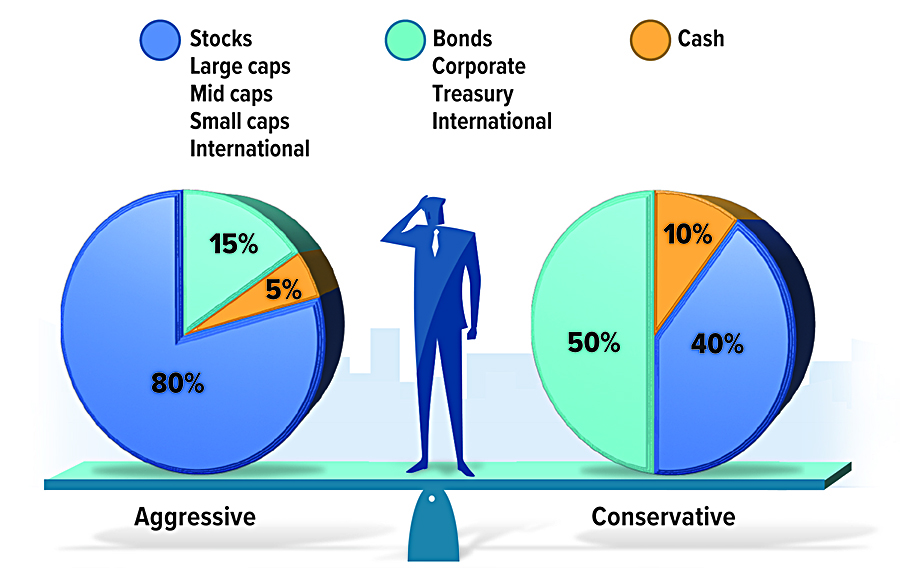Mixing It Up: Asset Allocation and Diversification
Asset allocation and diversification are so fundamental to portfolio structure that it's easy to lose sight of these strategic tools as you track the performance of specific securities or the dollar value of your investments. It might be worth considering how these strategies relate to each other and to the risk and potential performance of your portfolio.
Keep in mind that asset allocation and diversification are methods used to help manage investment risk; they do not guarantee a profit or protect against investment loss.
Establishing balance
Asset allocation refers to the mix of asset types in a portfolio — generally stocks, bonds, and cash alternatives. These asset classes have different growth and risk profiles and tend to perform differently under various market conditions. Stocks typically have higher long-term growth potential but are associated with greater volatility, while bonds tend to have moderate growth potential with less volatility. Cash alternatives usually have low growth potential but are the most stable of the three asset classes; however, if cash investments do not keep pace with inflation, they could lose purchasing power over time.
There is no right or wrong asset allocation. The appropriate allocation for you depends on your age, risk tolerance, time horizon, and specific goals. Younger investors might be comfortable with a more aggressive allocation heavily weighted toward stocks, because they have a longer time to recover from potential losses and may be willing to accept significant short- to medium-term drops in portfolio value in exchange for long-term growth potential. Older investors who are more concerned with preserving principal and those with near-term investment objectives, such as college funding, might prefer a more conservative allocation with greater emphasis on bonds and cash alternatives.
Adding variety
Diversification refers to holding a wide variety of securities within an asset class to help spread the risk within that class. For example, the stock portion of a portfolio could be diversified based on company size or capitalization (large cap, mid cap, and small cap). You could add international stocks, which tend to perform differently than domestic stocks. A well-diversified portfolio should include stocks across a broad range of industries and market sectors.
A portfolio's bond allocation might be diversified with bonds of different types and maturities. Corporate bonds typically pay higher interest rates than government bonds with similar maturities, but they are associated with a higher degree of risk. U.S. Treasury bonds are guaranteed by the federal government as to the timely payment of principal and interest. Foreign bonds could also increase diversification. Longer-term bonds tend to be more sensitive to interest rates; they typically offer higher yields than bonds with shorter maturities, but this has not been true since the unusual interest-rate increases that began in 2022.

Staying on target
Once you have established an appropriate asset allocation and diversification strategy, it's important to periodically examine your portfolio to see how it compares to your targeted structure. Depending on the level of change, you may want to rebalance the portfolio to bring it back in line with your strategic objectives. Rebalancing involves selling some investments in order to buy others. Keep in mind that selling investments in a taxable account could result in a tax liability.
The principal value of stocks and bonds fluctuate with changes in market conditions. Shares of stock, when sold, and individual bonds redeemed prior to maturity may be worth more or less than their original cost. Concentrating in a particular industry or sector could expose your portfolio to significant levels of volatility and risk. Investing internationally involves additional risks, such as differences in financial reporting, currency exchange risk, and economic and political risk unique to the specific country or region. This may result in greater share price volatility. The principal value of cash alternatives may be subject to market fluctuations, liquidity issues, and credit risk; it is possible to lose money with this type of investment.
Susan H. Stewart, CPM, JD,
Senior Vice President – Financial Advisor
Senior Portfolio Manager – Portfolio Focus
NMLS #830330 through City National Bank
Individual CA License # 0M18772
RBC Wealth Management, a division of RBC Capital Markets, LLC | Firm CA License # 0C38863
Ph: (302) 493-9161 | e-mail: susan.h.stewart@rbc.com
The Stewart Group - RBC Wealth Management - Home
RBC Wealth Management, a division of RBC Capital Markets, LLC | Firm CA License #0C38863
Ph: (301) 907-2705 | e-mail: taylor.stewart@rbc.com
Investment and insurance products offered through RBC Wealth Management are not insured by the FDIC or any other federal government agency, are not deposits or other obligations of, or guaranteed by, a bank or any bank affiliate, and are subject to investment risks, including possible loss of the principal amount invested.
The information contained herein is based on sources believed to be reliable, but its accuracy cannot be guaranteed. RBC Wealth Management does not provide tax or legal advice. All decisions regarding the tax or legal implications of your investments should be made in connection with your tax or legal advisor. RBC Wealth Management is not a mortgage lender or broker. Nothing herein should be construed as an offer or commitment to lend. Any calculations are provided as educational tools, and are not intended to provide investment advice or serve as a financial plan. The result of any calculation performed is hypothetical and does not assume the effect of fees, commissions, tax rates, or changes in interest rates or the rate of inflation, and is not intended to predict or guarantee the actual results of any investment product or strategy. These results depend wholly upon the information provided by you and the assumptions utilized within. In selecting an anticipated investment return, you should consider factors affecting the potential return, such as investment objectives and risk tolerance. The articles and opinions in this advertisement, prepared by Broadridge Investor Communication Services, Inc., are for general information only and are not intended to provide specific advice or recommendations for any individual.
RBC Wealth Management, a division of RBC Capital Markets, LLC, Member NYSE/FINRA/SIPC.
RBC Wealth Management does not provide tax or legal advice. All decisions regarding the tax or legal implications of your investments should be made in connection with your independent tax or legal advisor. No information, including but not limited to written materials, provided by RBC WM should be construed as legal, accounting or tax advice.
Past performance does not guarantee future results.
Prepared by Broadridge Advisor Solutions Copyright 2024.






















































